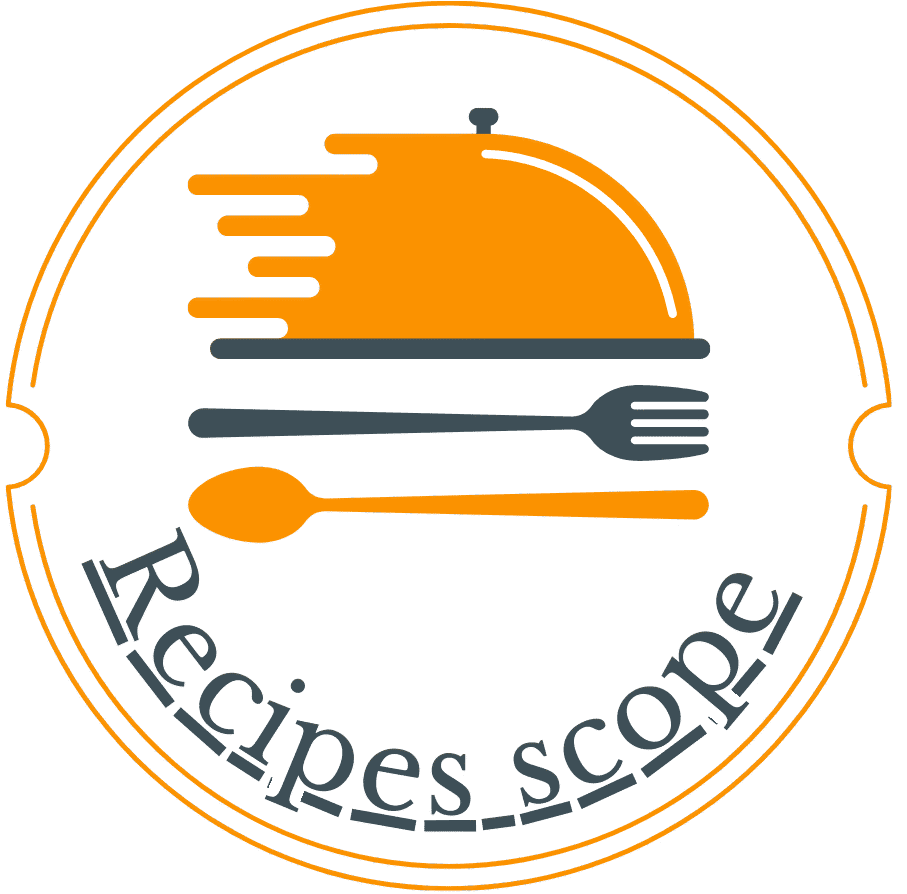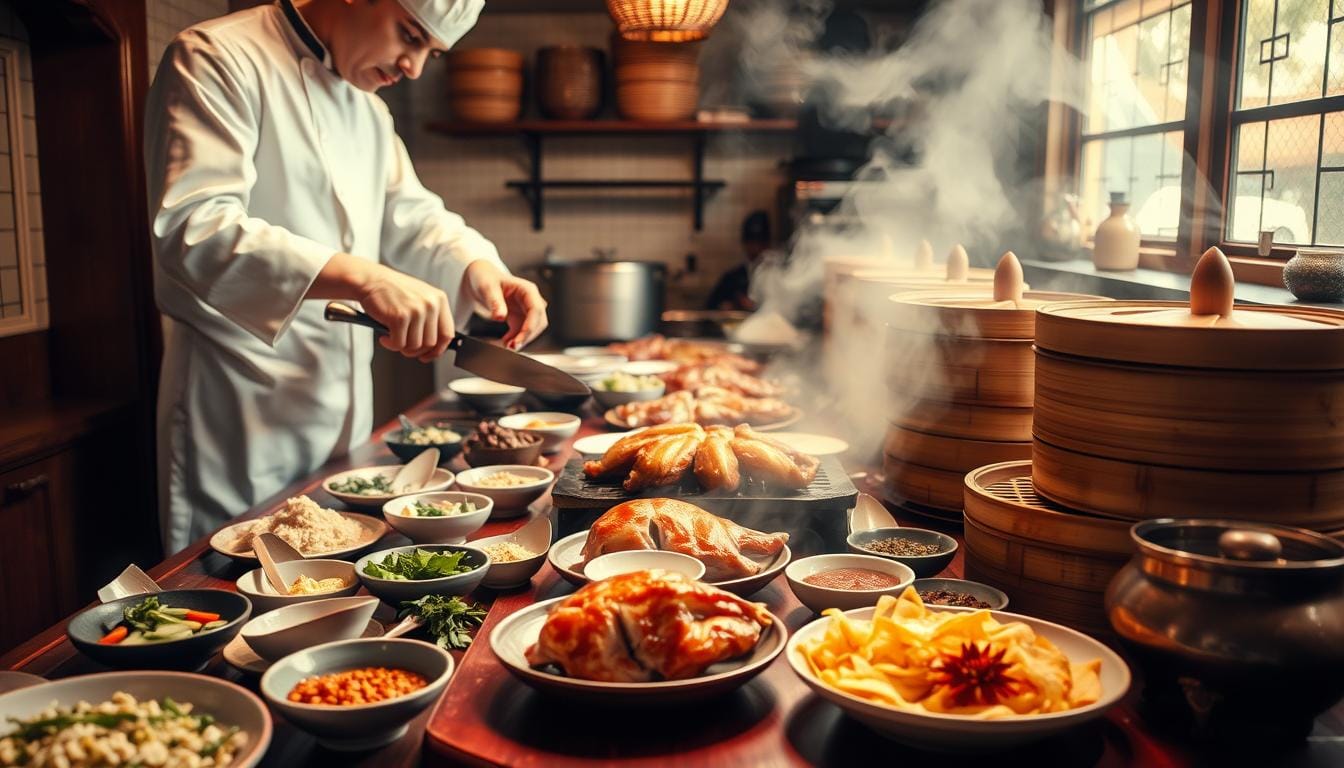Have you ever had a dish so amazing it took you to another world? The first time you try Chinese Peking duck, it stays with you. It’s not just food; it’s a peek into centuries of tradition and culture.
Creating this beloved dish is a journey of love. It combines history, flavor, and technique, making it a feast for the eyes and taste buds. Whether it’s the sound of crispy skin or the aroma in your kitchen, making your own Peking duck recipe is unforgettable.
On this culinary journey, you’ll discover the depth of Peking duck. From its royal beginnings to today’s innovations, we’ll explore it all. This journey will inspire you to not just cook, but to master the art of Peking duck.
Key Takeaways
- Authentic Peking duck is a reflection of China’s rich culinary heritage.
- The preparation involves historical techniques that enhance flavor and texture.
- Choosing quality ingredients is critical for a memorable dish.
- Learning traditional cooking methods can elevate your Peking duck recipe.
- Peking duck is more than a meal; it’s a cultural experience to enjoy with others.
- Modern twists on Peking duck offer exciting new flavors while respecting tradition.
Introduction to Peking Duck
Peking duck is a culinary marvel loved for its flavors and cultural significance. It has crispy skin and tender meat, making it a favorite in traditional Peking duck cuisine. The way it’s prepared shows centuries of Chinese heritage, including the imperial cuisine.
Exploring Peking duck history takes you from royal banquets to dinner tables today. This dish is more than a meal; it’s a mix of art and technique in Chinese cooking. As you learn about Peking duck, you discover the stories and traditions behind each bite.
The History of Peking Duck
Peking duck has a rich history, starting in the lavish tables of imperial Chinese cuisine. It’s known for its crispy skin and juicy meat. Over time, it went from a royal dish to a beloved food around the world.
Origins in Imperial Cuisine
The story of Peking duck begins in the Ming Dynasty, in the 15th century. It quickly became a favorite in the imperial courts. Emperors loved its special preparation and taste, making it a national treasure.
Evolution of the Dish Over the Centuries
As Peking duck’s fame grew, chefs worked to improve it. They used better ingredients and added special seasonings. Today, it’s a key part of Chinese food, loved by many, and stays true to its royal roots.
Traditional Techniques Behind Peking Duck
Peking duck is more than just a dish; it’s a work of art. The secret lies in the traditional roasting methods, like using a hanging oven. Master chefs spend years perfecting this skill. It’s what makes the duck’s flavor and texture so special.
The Craft of Hanging-Oven Roasting
The hanging oven method is key to Peking duck’s crispy skin. It allows chefs to control the cooking perfectly. The flames from hardwood add rich flavors, and the duck’s position ensures even heat.
As the duck roasts, its skin gets crispy, and the meat stays juicy. Achieving this requires skill and knowledge of temperature and timing.
Mastering the Preparation Process
Before roasting, chefs prepare the duck with care. They choose the best Beijing fat duck for its perfect fat-to-meat ratio. The duck is seasoned with a special blend of spices and marinades.
This marination time lets the flavors sink deep into the meat. Then, the duck is inflated to separate the skin from the meat. This step is essential for that crispy texture.
Key Ingredients for a Perfect Peking Duck
To make a Peking duck that you’ll remember, pick the right ingredients. The best duck for this dish is the Beijing Fat Duck. It’s known for its amazing taste and texture.
Choosing the Right Duck: The Beijing Fat Duck
The Beijing Fat Duck is special for cooking. It’s raised in the best conditions. This helps it grow with a rich flavor.
When looking for the best duck, find it from trusted suppliers. They should offer genuine Beijing Fat Ducks.
Essential Seasonings and Marinades
Along with the right duck, you need the right seasonings and marinades. Traditional recipes use five-spice powder, soy sauce, and honey. These ingredients make the duck taste even better.
A good marinade adds flavor and helps the skin get crispy. Choose high-quality seasonings for the best taste and look of your Peking duck.
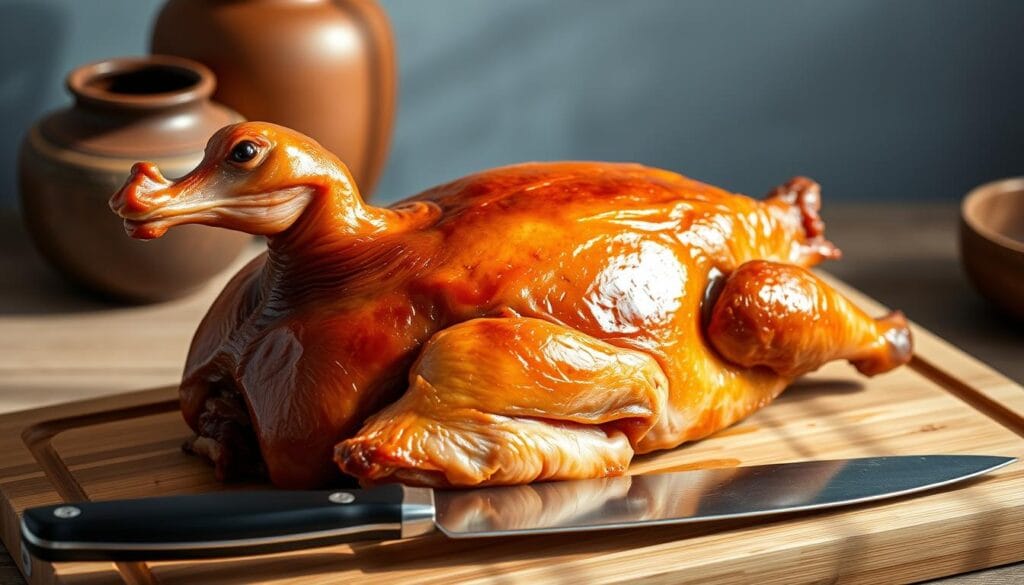
How to Cook Peking Duck at Home
Cooking Peking duck at home might seem hard, but it’s actually fun. This guide will walk you through a simple recipe. You’ll learn how to avoid common mistakes to get delicious, crispy results.
Step-by-Step Recipe Guide
- Preparation: Rinse the duck under cold water. Dry it with paper towels. Hang it on a rack if you have one.
- Marinating: Mix soy sauce, honey, five-spice powder, and rice wine for the marinade. Coat the duck well, making sure to get under the skin.
- Air Drying: Let the duck dry in a cool place for 4 hours or overnight in the fridge. This step is key for crispy skin.
- Roasting: Heat your oven to 375°F (190°C). Roast the duck for about 1 hour, basting every 15 minutes.
- Finishing Off: Raise the oven temperature to 425°F (220°C) for the last 15-20 minutes. This will crisp the skin.
- Serving: Let the duck rest for a few minutes before slicing. Serve it with pancakes, hoisin sauce, and scallions.
Common Mistakes to Avoid
- Not drying the duck well before marinating, which can stop it from getting crispy.
- Skipping the air drying step, which is essential for the right skin texture.
- Overbasting during roasting, making the duck soggy.
- Choosing a duck that’s too lean, which affects taste and texture.
Best Peking Duck Restaurants in Beijing
Looking for the best Peking duck in Beijing? Quanjude restaurant is a must-visit. It has a long history, dating back to 1864. They use special hanging-oven roasting techniques that make their duck stand out.
Quanjude: The Legacy of Peking Duck
Quanjude is famous for its Peking duck. People come here for the quality and tradition. The place has a unique atmosphere that takes you back in time.
Other Noteworthy Establishments
Quanjude is not the only place to try Peking duck in Beijing. Here are a few other great spots:
- Da Dong: Known for its crispy skin and innovation.
- Li Qun: A charming eatery that provides a rustic ambiance.
- Duck de Chine: Combines modern elements with traditional flavors.
Beijing is full of amazing places to try Peking duck. Each restaurant has its own special way of making this dish. You’re sure to find something you’ll love.
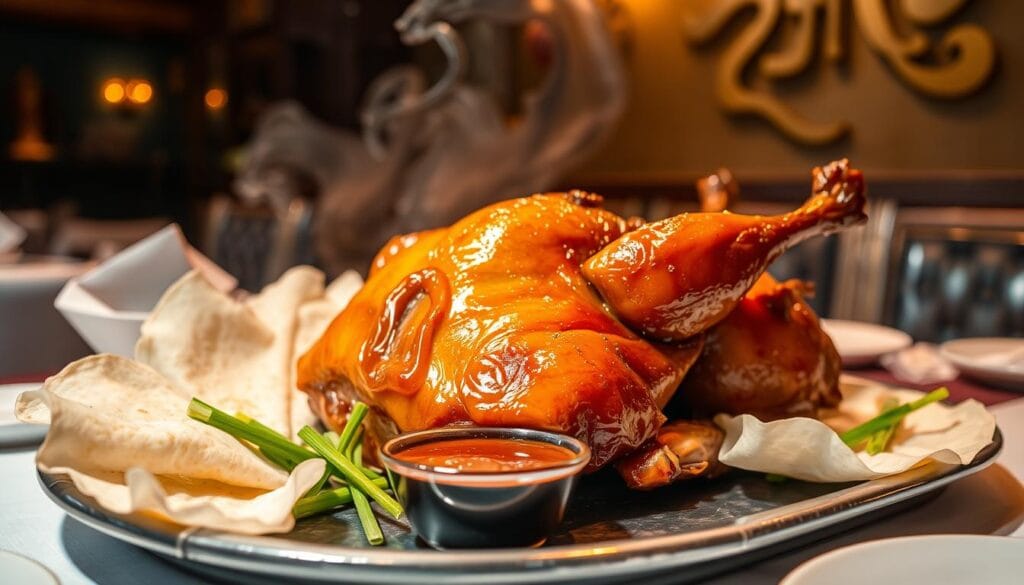
Chinese Peking Duck: Serving and Enjoying
Serving Peking duck is more than just a meal. It’s a special experience that celebrates culinary art. The traditional ways of serving it focus on how it looks and tastes, making diners excited from the start.
Traditional Presentation Styles
The way Peking duck is presented is very detailed. Chefs carve the duck right at your table, making the meal more fun. The duck is served in different parts, showing off its tasty skin and meat.
- Crispy duck skin served with thin pancakes.
- Accompanied by hoisin sauce and sliced scallions.
- The remainder of the duck can be served in soups or stir-fries.
How to Pair Delicious Sides
Choosing the right sides for your Peking duck can make the meal even better. Here are some popular choices that add to the flavor:
| Side Dish | Description |
|---|---|
| Chinese Scallion Pancakes | Flaky and savory, ideal for wrapping with duck. |
| Stir-Fried Bok Choy | Light and refreshing, providing a crisp contrast. |
| Vegetable Spring Rolls | Crunchy and flavorful, perfect for a starter. |
Modern Trends in Peking Duck Cuisine
The world of food is always changing, and Peking duck is at the forefront of these changes. Young people, thanks to social media, are looking for new and exciting food experiences. They love to mix old traditions with new ideas, making Peking duck a favorite.
Influence of Youth Culture on Traditional Dishes
Social media has a big impact on how we see and enjoy food. Young folks love to share pictures of tasty dishes, and Peking duck is a big hit. It’s a dish with a rich history, now mixed with modern looks, attracting a new crowd.
Many young people prefer to eat out in places that offer fresh takes on classic dishes. They enjoy trying new things and seeing how old favorites can be made new again.
Innovative Twists in Contemporary Cooking
Today’s chefs are all about trying new things with flavors, cooking methods, and how they present food. You might find Peking duck in tacos or gourmet sliders. These new ways of serving it keep the dish’s spirit alive while making it exciting for younger diners.
| Traditional Peking Duck | Contemporary Variations |
|---|---|
| Classic whole duck served with pancakes, hoisin sauce, and sliced vegetables | Peking duck tacos with spicy slaw and mango salsa |
| Served in a formal dining setting | Casual street food-style serving |
| Emphasis on rich flavors and traditional ingredients | Fusion flavors with international influences |
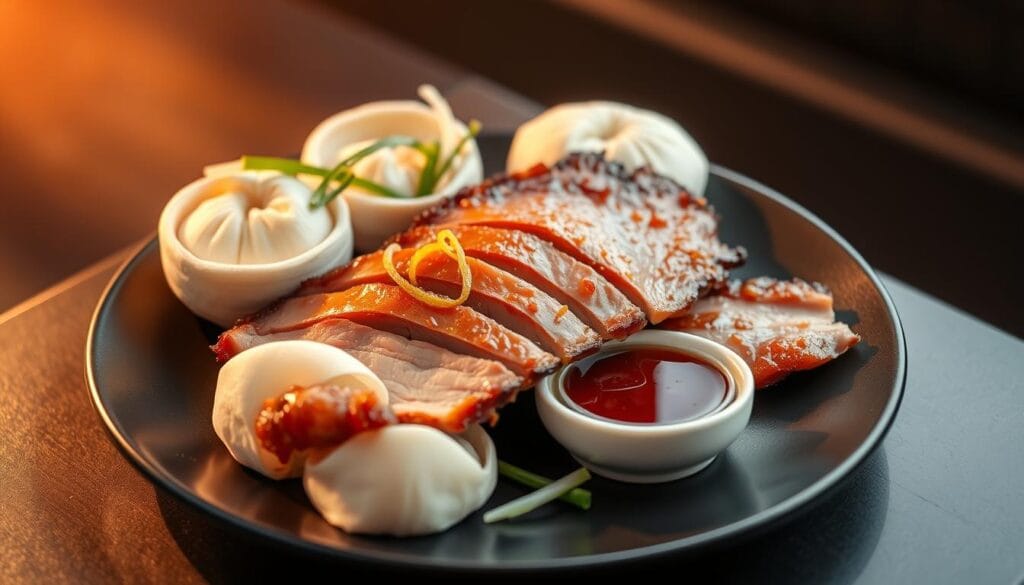
A Culinary Journey: Traveling for Authentic Peking Duck
Traveling to Beijing for Peking duck is more than just eating. It’s a dive into rich culture, amazing flavors, and social norms. You’ll find a lively scene where making and serving Peking duck is a show. Traditional spots look like old palaces, showing off centuries of food history.
What to Expect on Your Visit
Walking into a famous Peking duck place, you’ll smell the amazing food. You’ll get a friendly welcome, starting a fun night. The menu will have many choices, but focus on the Peking duck.
The staff might show off the duck, carving it at your table. They’ll tell you about the dish’s history and why it’s so special.
Insider Tips for the Best Experience
- Arrive Early: Busy spots fill up fast. Get there early for a relaxed meal and a good seat.
- Order Accurately: Ask for advice on sides that go with Peking duck. Try steamed pancakes and hoisin sauce for the best taste.
- Practice Dining Etiquette: Learn about Chinese dining rules. This includes using chopsticks right and sharing food.
- Engage with Staff: Ask them about the duck’s making and history. It’s a fun way to learn more about this dish.
This food trip not only feeds your taste buds but also connects you to a tradition. It’s about community and stories. Get ready to make unforgettable memories with every bite of Beijing’s famous dish.
Conclusion
Mastering Peking duck is more than cooking; it’s a journey into tradition and culture. We’ve looked at its rich history, key techniques, and special ingredients. This journey boosts your cooking skills and deepens your love for this art.
Remember, practice and authenticity are vital when mastering Peking duck. Every step, from prep to presentation, is important for that perfect skin and meat. This journey will bring joy and a sense of achievement as you make this dish.
Enjoying Peking duck is more than just eating; it connects you to the past and today’s tradition keepers. By understanding the prep and savoring the flavors, you join a long-standing tradition. Start your culinary journey and enjoy every step of mastering Peking duck.
